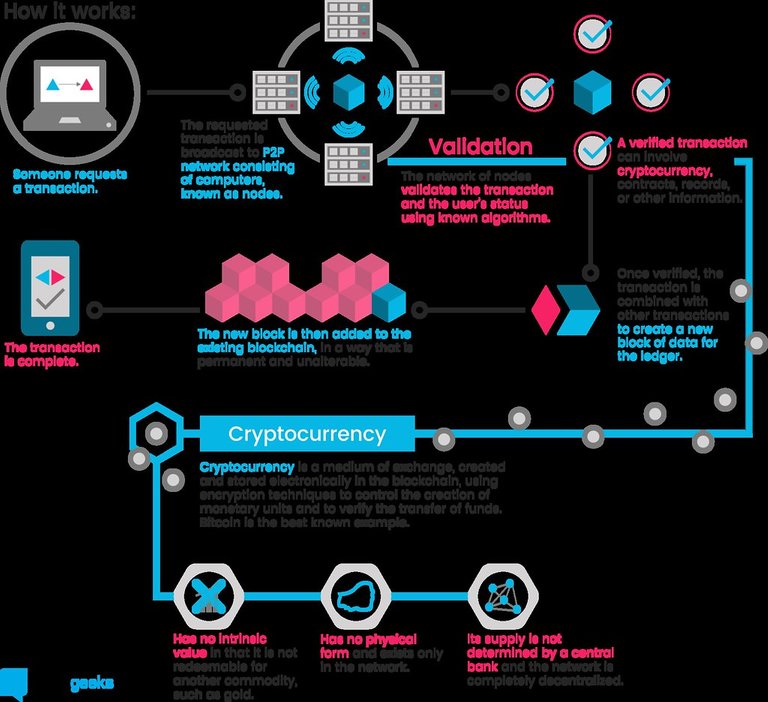Peer To Peer Networks: The Core Architecture of Blockchain Technology
Introduction
virtual money called Cryptocurrency is one of the applications running on blockchain technology as discussed in my last blog here, and since cryptocurrency is a subset of blockchain technology and blockchain technology itself is a subset of web 3.0. One may then wonder about the technological difference between cryptocurrency platform such as Hive, Bitcoin, Presearch, brave and the web 2.0 applications platform such as Google, Facebook, Flickr among others.
Diving into the subject matter
If you could remember in my last blog here, I asserted that blockchain technology is also having a database back-end, however, its database is so special due to its data storage mechanism in which data is enter through the block and then chain with already chained blocks followed by encryption before finally stored in the database. Unlike its predecessor (web 2. 0 technology) where the data is enter directly into table instead of block for final storage, though, it can still be edited by the authenticated user(s), example of database management system used in web 2.0 include: Mysql, Microsoft Access, Oracle among others.
The core architcture of block technology (Peer to Peer Networks)

Role of P2P in Blockchain
The main feature of blockchain technology is decentralized server system created using Peer to Peer Networks Architecture which is interconnected network of devices.
By the way, peer to peer networks is not a new technology, in fact, it has been in existence since the year 1980, it was first created for business solution before it was embraced by the public in 1999 through the music sharing service called Napster, created by Shawn Fanning (a college student then).
There are various definitions given to peer to peer networks (P2P). It all depend on the area of its application. When it comes to cryptocurrency or blockchain technology in general, we may refer peer to peer networks as a group of nodes that are connected together to form a strong network in such a way that each node can exchange digital assets or cryptocurrencies. Thus, this attribute of direct exchange within the network is why there is no need for third party in cryptocurrency and blockchain technology in general as against centralized system.
The formed network has the potential to store and share information within the connected nodes and each node maintains equal power to use the resources available within the formed network.
Using Bitcoin as an instance, it has a reachable active nodes of 9665 that made up of its network and that is according to GLOBAL BITCOIN NODES DISTRIBUTION as of today Thu Apr 15 2021, most of these nodes are in the United States of America, Germany, France, Netherlands, Canada, Finland e.t.c. You can click here to know more about the current size of the Bitcoin network including all the reachable nodes in the network and their locations.

Let me clear the misconception between the nodes on Bitcoin network and the users, It should be noted that the total number of nodes present in the network is different from the total number of bitcoin users.
Node as it is used here only refer to the nodes that made up the network as explained above while users only need to register his or her account with the exchange without necessary undergo identity verification.
Types of Peer To Peer Networks
Peer To Peer networks is classified based on its kind of architecture, basically there are three (3) types as listed below:
- Structured Peer to peer networks
This is an organized architecture since every node on the network have the opportunity to relate with one and other in order to perform function like file searching using the hash function which aids in data searching. Its limitation is that they tend to be more centralized and requires higher setup and costs maintenance.
- Unstructured Peer to peer networks
In this peer to peer networks, the nodes on the network are not well organized, thereby, making the interaction between the nodes random. Although, this is good for a task that demands a lot of processes like social network platform where people login and log out of the network, as such it always demand for a lot of Central Processing Unit and memory power in order to run properly.
- Hybrid Peer to peer networks
This is the combination of both peer-to-peer networks and client/server networks on a single platform. It tends to be more efficient than both structured and unstructured peer to peer networks. The centralized feature of structured peer to peer networks is combine with node equality feature of an unstructured network in order to build an efficient and a better approach peer to peer networks.
Benefits of Peer to Peer Networks
- Peer to Peer Networks serves as the core architecture of blockchain technology rendering it as a decentralized system with a lot of benefits like third party removal, privacy and lots more.
- Each time a node get down the other nodes will be available making it difficult to bring down the whole blockhain, this is achievable due to peer to peer network.
- Peer to peer networks provides high security when compared with traditional client-server systems. It is difficult to hack. The hacker has to deal with every node on the network. This is so, due to peer to peer network.
Final remarks!
No technology has advantage and leaves no disadvantage, despite the advantages that comes with Peer To Peer network architecture in blockchain technology as discussed above, however, the architecture requires that each time there is a new transaction, the in-built distributed ledgers need to be updated on every node present in the network, no doubt this will consume a lot of computing power to carry out the task across every node present on the network, as such the efficiency of the computer systems across the network will be reduced. This is definitely one of the issues surrounding its wide acceptance.
Thanks for following me up! If this is your first time here, consider reading my previous write-up here. Your reaction are important to me.
References
1. Application of Blockchain Technology
2. Bitnodes
3. Peer-to-peer networks
4. What Are Peer-to-Peer (P2P) Networks?
5. BLOCKCHAIN & ROLE OF P2P NETWORK
Very nice!